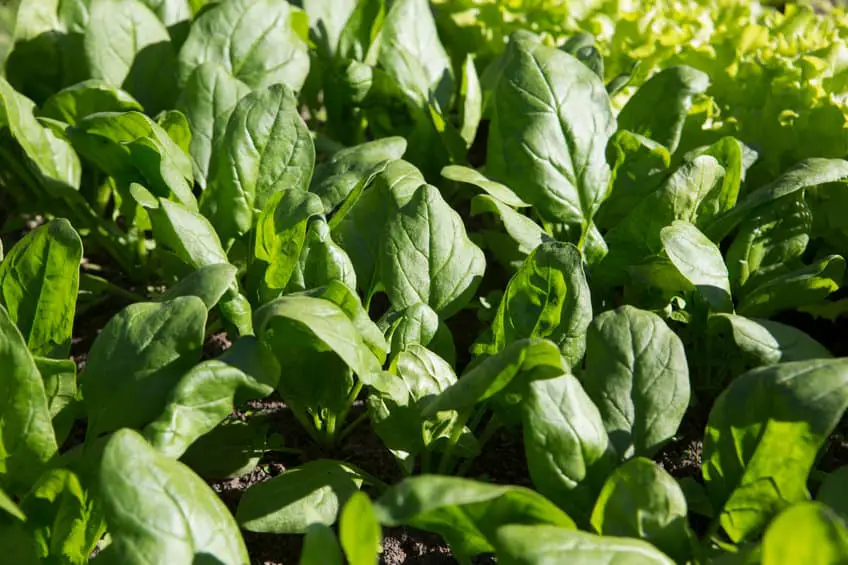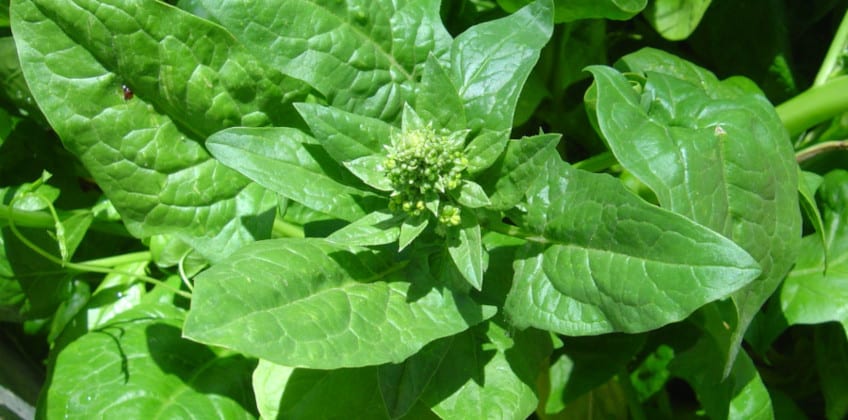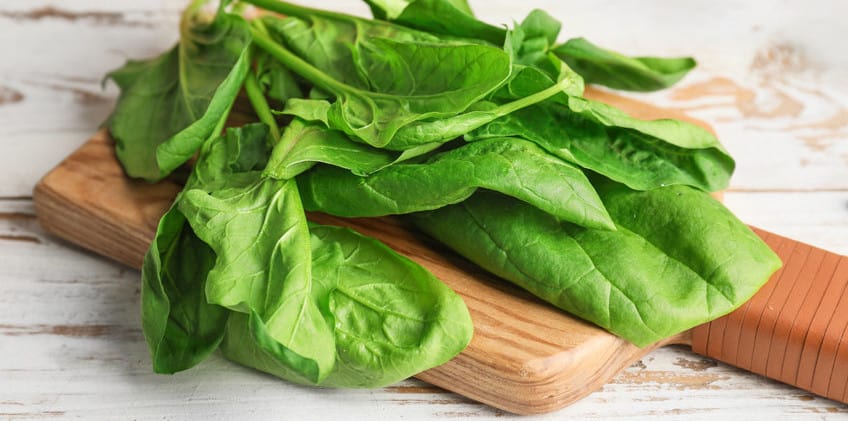This post contains affiliate links.
Some plants spread rapidly and take over more and more space when planted, but is spinach one of those plants? Does spinach spread in the garden? The answer is actually not that straightforward, so I have written this article to give you the answer.
Spinach does not spread in the garden in the same way some other plants do. A spinach plant will stay in its place and not spread horizontally by producing runners or similar. That said, there is one way spinach can spread naturally.
Even though spinach doesn’t spread like certain other plants, such as mint or blackberries, there is actually another way it can spread, and that is by reseeding itself. In this article, I explain how spinach can spread through reseeding as well as how you can stop it or encourage it, depending on what you want. I also present two methods for harvesting your spinach, so it keeps growing back over and over, so keep reading to learn that.

How Spinach Can Spread Naturally (By Reseeding Itself)
Perhaps you want your spinach plants to spread in the garden so you can get a lot more spinach for free, or perhaps you don’t want it to spread so that you can be in control of where it grows.
Whether or not you want your spinach to spread in the garden, you should know how it works.
Unlike certain other garden plants, such as mint, oregano, and thyme, which all spread by producing horizontal runners that grow out from the plants, spinach does not spread. At least not like that.
Those three plants (and many more) naturally grow larger and larger as the runners they produce establish themselves further and further away from the center of the plant, making the whole plant wider and wider.
Spinach does not spread by producing runners, but there is another way it can spread naturally, and that is by reseeding itself. This can make spinach spread a lot since the seeds can end up far away from the plant they came from.
Reseeding itself basically just means that the spinach plant is allowed to go to seed and that the seeds it produces are spread and grow by themselves without you having to do anything (other than watering when they grow).
The seeds from a flowering spinach plant can end up far away from the plant they came from. This can either be because the wind is carrying or pushing them around or because birds pick the seeds from the plant and drop them somewhere else. Usually, most of the seeds will end up on the ground around the original plant.
If you don’t do anything to your spinach and just let it go to seed, chances are the seeds will fall off or be spread around, as I explained above. If you don’t want this to happen, scroll down to the next headline as I explain how to stop it.
According to this article from Washington State University, spinach is even a very hardy plant that can withstand frost, so if your spinach goes to seed in the late summer or spring, you might see some unexpected spinach plants around your garden next spring.
It might seem nice that spinach can reseed itself like that, and it certainly is a good way to get a lot more spinach for free, but there are two problems with it.
Firstly, you have very little control over where the seeds end up, so if you let them go to seed, new spinach plants might start to show up in random places around your garden.
Because of this, it can be a good idea to collect the seeds and resow them manually, so you have full control over where they grow back. To collect spinach seeds, simply wait for the stalk and flowers to dry up. Once it is dry, you can collect the seeds from the seed pods that are found around the flowers.
Secondly, according to this article by Rhoda Burrows, Professor & SDSU Extension Horticulture Specialist at South Dakota State University Extension, spinach is an outcrossed plant, meaning it is dependent on the pollen from different plants to produce seeds.
Because of this, the seeds will rarely come true, meaning they are usually genetically different from the plant they came from. This is not necessarily a problem, but you should know that you will most likely get a slightly different type of spinach.
If you don’t want your spinach to reseed itself, don’t worry, stopping it is very simple. I explain how you can do that below.
How to Prevent Spinach From Reseeding Itself and Spreading

If you don’t want your spinach to reseed itself, you have to stop it before it goes to seed. Luckily, that is very easy.
To stop spinach from going to seed, simply cut the stalk that begins to grow from the center of the plant as early as possible. The stalk is usually the first sign that spinach is starting to go to seed, and cutting it redirects the plant’s energy back into growing and producing leaves.
When spinach begins to bolt, flower, or go to seed (call it what you want), most of the plant’s energy is used for that, and very little is used for growing and producing leaves. So if you want to harvest as many leaves from your spinach as possible, you should stop it from bolting as fast as possible as that will make it use the energy on growing and producing leaves again.
As I mentioned, one of the first signs spinach is about to bolt is that a stalk with flower buds at the end starts to grow from the center of the plant. You can see how this looks in the photo above. The stalk and flowers are not the only signs, though, so to be prepared, I recommend reading this article where I cover what you should know.
When you notice that stalk, make sure to cut it as fast as possible. It is always best to use some clean and sharp pruning shears for tasks like that, as they will make the cleanest cut with the lowest risk of damaging the plant. If you don’t already have pruning shears, these (link to Amazon) are really good. I use them myself and I am very satisfied with them.
Spinach usually begins to go to seed when there is a lot of sunlight and high temperatures (read more) and when it happens, it can happen fast, so you need to keep an eye on your plants. If bolting happens too fast, it can sometimes be best to simply pull the plant from the ground and throw it away.
Harvesting Spinach So It Keeps Growing Back Over and Over

One of my favorite things about growing spinach is that you can harvest it without actually killing the plant but instead in a way so that it keeps growing back over and over again.
I have two methods to share with you for harvesting spinach, so it keeps growing back. I use the two methods in slightly different situations, which I explain below.
Both of these methods are ways to increase the overall yield of your spinach. If you want some more tips for that, I recommend reading this article.
Method 1: Harvest the outer leaves one by one
Harvesting the outer leaves of a spinach plant one by one while leaving the plant in the ground allows the plant to keep growing. Just make sure to leave at least a couple of leaves on the plant as they will help the plant absorb sunlight and thereby grow back faster.
You can harvest spinach this way more or less as often as you want, as long as you make sure to leave some leaves on the plant. The more leaves you leave on the plant, the faster it will grow back since they help with absorbing sunlight.
This method works best if you have several spinach plants since you can usually only harvest a couple of leaves per plant at the same time.
I use this method when I have several spinach plants that aren’t so big yet, but I still want to harvest some leaves from them. If you have a fully grown spinach plant that is ready to be fully harvested or perhaps even about to start bolting, the next method is better.
Method 2: Cut the whole plant an inch from the ground
This method is probably the easiest for harvesting spinach.
Simply cut the entire plant about an inch or two (2.5-5 cm) from the ground but let the base of the plant (with the roots) stay in the ground.
The theory behind this method is similar to the other method I explained. The primary difference is that this method is better for larger, mature spinach plants and plants that are about to start bolting.
The negative thing about this method compared to the one above is that it takes longer for the plant to grow back. The upside is that you get to harvest more leaves from each plant at the same time.
